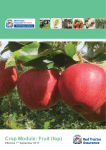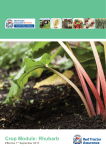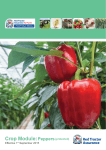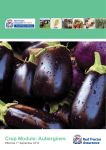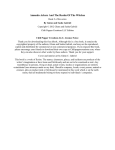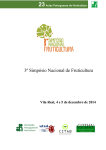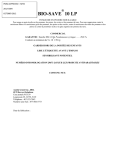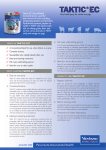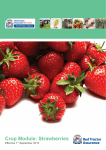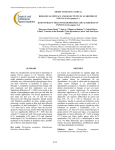Download Crop Module: Hops - Red Tractor Assurance
Transcript
Crop Module: Hops Effective 1st September 2015 Welcome T his crop specific module for hops has been written to complement and avoid duplicating the generic principles of the Red Tractor Farm Assurance Fresh Produce Scheme standards. It is advisable to read the Red Tractor Farm Assurance Fresh Produce standards before reading this crop specific module. This module is designed to stimulate thought in the mind of the reader. It contains crop specific guidance and standards, where applicable, in addition to the requirements stated in the generic Fresh Produce standards. Within this module the important requirements outlined in the crop specific standards section will be verified during the Red Tractor Farm Assurance assessment and compliance will form a part of the certification/approval decision. Disclaimer and trade mark acknowledgement Although every effort has been made to ensure accuracy, Assured Food Standards does not accept any responsibility for errors and omissions. Trade names are only used in this module where use of that specific product is essential. All such products are annotated® and all trademark rights are hereby acknowledged. Notes: Pesticide Information General Introduction Following a systematic approach will help growers identify and manage the risks involved in crop production. This module is based on a typical crop production process and food safety, health & safety, environmental and quality hazards are identified. Appropriate controls may then be established to minimise risk. Food safety and health & safety issues always take precedent over quality and environmental controls. The layout of this module follows the same structure as that used in the Red Tractor Farm Assurance Fresh Produce Standards. The content of the module is reviewed prior to the issue of updated editions. The review process considers both new developments and all relevant technology which has emerged since the last review was completed and which have been found to be both workable by the grower and beneficial to the environment. The aim is to transfer such information and technologies to growers. Acknowledgements Red Tractor Farm Assurance Fresh Produce gratefully acknowledges the contribution of all consultees in the preparation of this protocol, particularly members of the British Hop Association and Peter Glendinning. The Red Tractor Fresh Produce team has been working with Fera to provide tailored access to the LIAISON database for all Red Tractor Fresh Produce members. This system allows individual growers access to all information for plant protection products approved for use under the Red Tractor Fresh Produce Scheme. LIAISON can be accessed under the Produce tab via the “Checkers and Services” page where you will also find a user manual. Searches will be filtered specifically for the crops for which you are registered. Once you have logged onto the site and clicked on the LIAISON hyperlink you will be directed to the LIAISON home screen. You will need a username and password and these will be sent once you have registered: http://assurance.redtractor.org.uk/rtassurance/ services/Registration/members.eb . Front cover image credit: Peter Glendinning. 1 Red Tractor Assurance for Farms – Crop-specific Module: Hops © Assured Food Standards 2015 Content Contents ADDITIONAL REQUIREMENTS AGAINST CURRENT STANDARDS 02 CROP SPECIFIC STANDARDS02 CHOICE OF VARIETY, ROOTSTOCK AND PLANT HEALTH CERTIFICATION03 ENVIRONMENTAL PROTECTION AND CONTAMINATION CONTROL04 PEST, DISEASE AND WEED CONTROL 05 NUTRITION 08 HARVEST AND STORAGE 08 RESIDUES AND CONTAMINANTS09 HEALTH AND SAFETY WORKER WELFARE 09 APPENDIX 1: FERTILISER RECOMMENDATIONS FOR HOPS 10 APPENDIX 2: VERTICILLIUM WILT OF HOPS 11 APPENDIX 3: RECORDS OF PESTICIDE APPLICATIONS 13 APPENDIX 4: HARVEST AND STORAGE CHECKLISTS 14 ADDITIONAL REQUIREMENTS AGAINST CURRENT STANDARDS None for this crop module CROP SPECIFIC STANDARDS RECORDS (to be kept for 2 years) STANDARDS HOW YOU WILL BE MEASURED CQ.26.a It is possible to trace the following for each bale or pocket of hops: – variety & field name (permitting reference to the record of pesticide applications) – harvest date – kiln or oast number (if appropriate) time & date of drying – weight of pocket or bale (and from which core samples were taken) – date put into storage or dispatched Each pocket or bale must be correctly labelled or marked CQ.26.b Hop picking and cleaning machines, and conveyors of both green and dried hops, are cleaned before harvest each season and that this is recorded Red Tractor Assurance for Farms – Crop-specific Module: Hops n op pocket/ bale H traceability records n leaning records for C picking/ cleaning/ conveying machines © Assured Food Standards 2015 2 STANDARDS HOW YOU WILL BE MEASURED RECORDS (to be kept for 2 years) CQ.26.c Smoking must not occur inside the buildings where hops are being dried, conditioned, pressed and stored n Kiln CQ.26.d burner service records Kiln burners must be checked annually and serviced to prevent fuel aerosols from fouling the crop GUIDANCE CHOICE OF VARIETY OR ROOTSTOCK AND PLANT HEALTH CERTIFICATION Hop plants may be cropped for over 20 years, so it is important that the original planting is free from debilitating virus and viroid disease (some of them symptomless). Specialist hop propagators, located outside the main hop growing areas, supply certified disease-free stock under the A-plus approval scheme. But now there is a new threat to British hops in the form of Hop Stunt Viroid, which is active in the USA and Asia. It is important that all hop plants grown in Britain come from PHPS registered nurseries as these are inspected by Plant Health officials. If Hop Stunt Viroid were to be introduced into the UK it would devastate the industry. So all hop plants should come from a reputable source. If in any doubt, please speak to Dr. Peter Darby at Wye Hops Limited. Please don’t risk bringing plant material from any overseas trip back here. In addition, it has recently been established that Hop Stunt Viroid (HSVd) is carried in oranges, the peel of which can readily infect hop plants. Although grapes and plums are now carriers of HSVd, the main risk to plant health in british hops is from discarded orange peel, as demonstrated in Slovenia in 2013. Planting records should be kept to demonstrate and maintain the purity of each variety. All purchases of hop plants should be logged and planting records for both new and replacement plants should eliminate any ambiguity. Please note that within PHPS and Fera, hops have always been a separate category to fruit and vegetables, and potatoes. The greatest threat to plant health in hops is the introduction of new plant diseases. This is very likely because the importation of hop plants into the UK is not subject to any restrictions other than freedom from wilt disease. Hop Stunt Viroid is a good example of this problem. As an organism, it is already present in the UK in grapevines, but it has not yet been found in UK hops 3 and the mechanisms that could enable it to do so are not known and may not exist. Although it has infected hops in an EU country (Slovenia) this should serve as a warning. Logically, it should be treated as a non-indigenous recognised disease of hops. Since the organism (not the disease) is already in the UK, FERA will not make this restriction. Most responsible exporters respect this problem and the research organisations in the USA, for example, are not sending untested plants to the EU. So, since there are no restrictions or inspections of imported hop plants, private individuals in the USA are able freely to export plants, and private individuals in the UK are able to import them without hindrance. There are already examples of this on-line, and this unregulated trade is potentially disastrous for the UK hop industry. There are other non-indigenous diseases of hops such as American Hop Latent Virus. At the moment, hops are not a distinct category within the plant health import procedures. They fall into the general “other plants for planting” category. There are no grounds to reject a consignment if the paperwork is in order. The unregulated casual trade in hops plants may be reduced if hops were made a distinct category within FERA, making the plant health inspectors at our ports more aware of them. The highest priorities for hop plant health should be: 1. Freedom from Hop Stunt Viroid, which should be added to freedom from wilt, as a requirement for an EU Plant Passport. 2. Imported hop plants should be specifically declared ‘tested’ and ‘free of Hop Stunt Viroid’ and ‘American Hop Latent Virus’ as part of the phytosanitary certificate. 3. Any importation of hop plants, including by private individuals, should be subject to Plant Health inspection of the phytosanitary certificate at the point of entry into the EU. Red Tractor Assurance for Farms – Crop-specific Module: Hops © Assured Food Standards 2015 ENVIRONMENTAL PROTECTION & CONTAMINATION CONTROL THE BASIC APPROACH TO CROP PROTECTION Pest and disease recognition The hop is a rapidly growing and strongly three-dimensional plant and since the thresholds for the presence of the main pests and diseases are at present all set at zero. There are times when certain levels of pest infestation can be tolerated, but for diseases this is not good practice because hops are grown as perennial plantations in blocks, in which the plants of each variety are genetically identical. It is crucial that personnel responsible for crop protection are able to recognise pests and diseases in their early stages: a useful set of photos has been circulated to the industry in .pdf format. The importance of regular crop inspections for Verticillium wilt cannot be over-emphasised. It is useful to record all field examinations, not only to facilitate the choice of management tools (e.g. fertilisers and pesticides), but also for future reference to compare performances between different fields and seasons. CHOICE OF PLANT PROTECTION PRODUCT Pesticide Approvals Lists of pesticide products currently approved by DEFRA CRD for use on hops in the UK are circulated annually by the BHA. They are circulated to all growers either directly or through their Producer Organisations. It is important that all users of pesticides are familiar with the instructions and restrictions of individual pesticide products. Where relevant, users should be in possession of copies of ‘Extensions of Authorisation for Minor Use’ (EAMU) Approval notices. Growers receive copies of these notices from the BHA as they are issued, but they can also be obtained by accessing the CRD website e-approvals or by contacting the British Hop Association. The notices contain the necessary rates and restrictions for approved uses on hops. * Please beware that the CRD website list of Off Label Extension Approvals for hops does not segregate those permitted for use on the growing crop intended for harvest, from those only permitted but with a 12 month harvest interval, e.g. those being grown as nursery hops or being idled. In fact the majority of Off Label Approvals listed are only permitted to be applied if crop is not harvested within 12 months of the application! The surest way to be certain is to check the last paragraph of each individual Notice of Approval document for each chemical, headed ‘Other specific restrictions’. * Hop growers should also be aware that in addition to the statutory restrictions placed on pesticides by CRD, there are also industry restrictions imposed by brewers through the British Beer and Pub Association (BBPA). A list showing the conditions for the ‘acceptance’ of each chemical pesticide is published every year as a BBPA Technical Bulletin circulated to their UK membership every year, and is often referred to by hop merchants and hop producer organisations. Although it is an advisory bulletin, not a legal document, it is used by Brewers following ‘due diligence’ procedures for raw materials. However, the BBPA have now started circulating lists of chemicals used on hops abroad, not just in the UK. APPROVED USES NOT INCLUDED ON THE PRODUCT LABEL In many circumstances, particularly for minor crops, product labels do not include all of the approved uses and growers and advisers wishing to check the approval notice of a particular product should note that this information is available using the LIAISON® search, accessible via their Red Tractor Farm Assurance home page after logging in. A search on the ‘Extensions of Authorisation for Minor Use’ page of LIAISON® by crop or product name will yield a results page. A click on the product name will link to a summary of the approval information. Near the bottom of the summary is the Approval Number (e.g. 0246/09) and this link will open up a pdf of the current EAMU document giving details of the extension of use. In the case of products with older approval an electronic approval may not be available. In these cases growers should contact the CRD Information Services Branch for details of the approved conditions of use. Contact details are: [email protected] tel. 01904 455775. For various reasons the use of some approved pesticides may not be acceptable to processors. In order to confirm to such requirements, proposed applications should be confirmed with the contracting company. Application methods for pestcides Reduced volume spraying is generally regarded as inappropriate for hops. Growers wishing to adopt lower volumes must ensure that the restrictions on the pesticide labels are adhered to. Red Tractor Assurance for Farms – Crop-specific Module: Hops © Assured Food Standards 2015 4 RECORDS OF APPLICATION Recording and reporting Records of Pesticide Applications should be available upon request to your Producer Organisation, for its own records or inspection by its (your) customers. These should show a minimum of the following information: n Title: Record of pesticide application n Year n Grower name n Grower EEC number n Pocket or bale numbers pertaining to the record n Variety n Field n For name(s) each date of application: – Product name(s) – Active substance – Justification for use – Dilution rate of product – Spray volume – Rate of product used per hectare n Harvest start and finish dates n Authentication signature A copy of an example form can be found in the Appendix (for an electronic copy contact BHA). PEST, DISEASE AND WEED CONTROL PEST CONTROL Damson hop aphid (Phorodon humuli) A voracious sap sucker with a tolerance threshold of zero. Aphids migrate into hops from May to August. They prefer to colonise young growth and breed rapidly with up to eight generations per season. Winged aphids return to Prunus species starting in August. The infestation in hops results in a marked reduction in plant vigour, with premature leaf-drop and yield loss. In addition to direct physical damage, the contamination of hop cones by the sooty moulds, feeding off the honey-dew, results in a reduction in crop quality. Even a trace of these sooty moulds in a crop can render it unmarketable. 5 All varieties, except Boadicea (a new variety completely and naturally tolerant) are susceptible to attack by aphids. Control on some varieties is more difficult than on others, the worst being those varieties with early maturing large open cones. Over the past 30 years the Damson hop aphid has been one of the most successful in gaining resistance to most groups of insecticides. Control measures should not rely on only one active substance, as this will encourage the development of resistant populations. Growers now have Movento (spirotetramat) as well as Mainman (flonicamid), Plenum (pymetrozine) and Admire (imidacloprid) available to use, although the latter is now largely ineffective. There is no other useful chemicals registered for use in the UK, and no other reliable control technique so growers should be mindful of resistance management and constantly ‘ring the changes’ regardless of the difference in costs between these products. As soon as an aphid develops resistance to a chemical on one farm, its off-spring will be flying-in to hops on all neighbouring farms the following season. Two-spotted spider mite (Tetranychus urticae) Often misnamed ‘red spider mite’ with a threshold tolerance of zero. Mites emerge from diapause from early spring to as late as early June (depending upon temperature - for detailed research on this refer to work by Dr. C. Campbell at HRI East Malling). They feed mainly on the underside of leaves initially causing the characteristic light speckling, followed by extensive bronzing and bleaching of leaf tissue and subsequent leaf drop. In severe cases, total defoliation can occur. The breeding rate of this mite is related to temperature and relative humidity, and is most favoured by hot dry conditions. Breeding continues throughout the growing season and mites return to diapause from mid-September. Favoured sites for diapause are dry and sheltered (cracks in hop poles, hollow plant tissue like straw and old bine material), but significant numbers over-winter in cracks in the soil surface and between the scales of the buds on surface hop shoots. This mite also attacks many other crops in which regular applications of acaricides may also be required. This has contributed to the high level of resistance now possessed by mites against several groups of acaricides. Growers have to rely on chemical acaricides to control this persistent pest. Treatments are usually most effective applied in late May / early June, and then best repeated within three weeks. The choice of effective approved acaricides is limited to Agrimec (abamectin) and more recently Envidor (spirodiclofen). Masai (tebufenpyrad) is still approved but largely ineffective with resistant populations now widely developed. Red Tractor Assurance for Farms – Crop-specific Module: Hops © Assured Food Standards 2015 There is no other technique established for controlling the two-spotted spider mite on hops. Despite the apparent success in other crops using introductions of predatory mites, further developmental research is required. Hop propagators can assist growers by using predatory mites. Of more benefit to the grower is the fact that numbers of over-wintering mites can be significantly reduced through the practice of spring pruning or rank-bining (removing the first flush of shoots in the spring). Good basal defoliation also benefits mite control. Other pests of hop Since UK hop growers have not used OP pesticides for many years, and have now moved away from using a basal drench of imidacloprid for aphid control, they are now seeing an increase in other pests, some of which have destroyed whole crops in the last few years. These pests need to be recognised, and when necessary controlled, but the only chemicals permitted are broad spectrum pyrethroid insecticides which are so damaging populations of natural predators that they often cause further and larger problems with aphids and mites. These pests may not be new to hops, but they are to most hop growers. They mostly prefer a shady environment and growers are encouraged to keep plants on the thin side. They are also most damaging to hops on low trellis wirework, where it is recommended to keep bine numbers between 4 and 8 per metre for optimum yield and to reduce leaf shading. Growers and agronomists need to familiarise themselves with the following pests: Hop Flea-Beetle (Psylliodes attenuatus); European Corn Borer (Ostrinia nubilalis); Rosy Rustic Moth (Hydraecia micacea); Silver Wye Moth (Autographa gamma); Currant Pug Moth (Eupithecia assimilata); Brown banded thrips; and last, but by no means least, the insidious Common Green Capsid (Lygocorris pabulinus). British hops are exposed to the risk of serious crop losses from pests that are largely unfamiliar to growers and against which there are no suitable control measures available. DISEASE CONTROL Hop Wilt (Verticillium albo atrum) Responsible for driving many growers out of hop production, and there is still no cure in sight! It is essential that all growers and crop advisers are fully aware of all the symptoms of this the most pernicious disease of the hop. Extracts from the DEFRA information sheet ‘Verticillium Wilt of hops’ can be found in the Appendix. In the absence of statutory measures to control the spread of this disease, Producer Organisations should take the initiative by demanding best practice of their members. Simple restrictions could be entered into the ‘Common Rules of Production’ that form part of the legal agreement between each hop producer organisation and its individual grower members. Hop downy mildew (Pseudoperonospora humuli) No hop variety is immune from attack, but they all differ in their response to the disease. It is almost impossible to eliminate once established in the rootstock and so the tolerance threshold should be zero. Cleanliness of new plants is paramount because downy mildew can kill young plants quickly, or damage them such that they die over-winter. Downy mildew emerges each spring from systemically infected shoots growing from the rootstock. These basal or primary ‘spikes’ produce spores that infect other shoots and leaves. In warm and humid weather conditions, the disease can infect unprotected plant tissue very rapidly indeed, especially during burr and cone development. The disease is able to survive on nettles, using them as a ‘green bridge’. All varieties should be regarded as susceptible, with some like Target, clearly very susceptible to the disease. Control of downy mildew is best achieved with prophylactic fungicide sprays. Growers are advised to use those with systemic activity in the spring to reduce primary spike, and then eradicant chemistry to eliminate secondary infection in June to allow more successful crop protection during burr and cone development. Adequate protection of the developing burr and hop cones is crucial and the best results are from the use of mixtures with systemic chemicals during burr. Damage to crop yield through subclinical levels of disease in the plant is not documented. Hop plants with any significant level of infection are a serious hazard to neighbouring crops and should not be tolerated. Surprisingly few infected hop cones in the ‘sample’ can render a crop unmarketable. Hop powdery mildew (Podosphaera macularis, previously Sphaerotheca humuli) A disease that can spread in a wide range of conditions, almost every day of the hop-growing season in the UK, and again a disease with a tolerance threshold of zero. Powdery mildew is now endemic in almost all hopgrowing regions in the world. Although it favours mild and damp growing conditions, it can also reach epidemic proportions in desert conditions! Its voracity depends largely upon the susceptibility of the hop variety grown. Summer (asexual) spores can over-winter between the scales of buds, and these emerge to infect new tissue each spring. The disease can also over-winter as ascospores (held in chasmotheicia) that are released in the spring to infect the new growth. Disease inoculation can be significantly reduced by spring pruning, and is discouraged by removal of unwanted basal growth (both by hand at training time and by subsequent chemical Red Tractor Assurance for Farms – Crop-specific Module: Hops © Assured Food Standards 2015 6 basal defoliation). The disease can spread very quickly on young tissue and inadequate control often results in a serious epidemic. The degree of infection need only be small to render a crop unmarketable because the alfotoxins released by the disease are toxic to the yeasts in breweries. The disease mutates readily, and only the new variety Endeavour can in anyway said to be ‘immune’. It is the degree of both risk and susceptibility that largely determine the programme of control measures taken. It is useful to note that once infection can be spotted with the naked eye (as a small white fleck), it has already been sporulating for a few days. The precursor symptom to white flecks can be small yellowy oily patches, which then develop white flecking on the underside of the leaf first. Control measures rely entirely upon chemical fungicides, which are usually applied in a programme of regular (typically fortnightly) sprays, from shoot emergence in the spring until harvest. Breaks in the spray programme usually lead result in increased infection. Growers should aim to eliminate all traces of the disease before the onset of burr, because after this time satisfactory control is rarely achievable. For further information on the nature of these or other pests and diseases, refer to ‘hops’ by RA Neve (published by Blackman), or seek advice from your hop producer group, the National Hop Association or your crops adviser. Late Season Diseases (e.g. Alternaria alternata) Infection is usually seen after injury to the delicate developing hop cones (especially Goldings) in August, often following a characteristic late summer storm. Alternaria infection usually results from close proximity to wheat and oil seed rape, causing a brown discolouration to the surfaces of hop cones, and forces an early harvest. The grey mould of Botrytis in the cones is rarely seen in the UK, preferring the warmer more humid conditions found in southern Europe in late August. But Fusarium ‘cone tip blight’, recently identified as a problem in Oregon, is sometimes seen in the UK in varieties with long pointy cones. Protection against all these diseases is more difficult where there is powdery mildew infection. Chemical protection using the product Bellis (boscalid + pyraclostrobin) is at present the only option for UK growers threatened by Alternaria and Fusarium, although late season applications of these persistent chemicals can leave residues in the cones, hence the more visible MRLs for these chemicals. 7 The disease Phoma exigua has been reported to cause a leaf spot and cone necrosis in Slovenia. Disease symptoms of Phoma wilt first appear as chlorotic spots on bines but progress to oval shaped grey-white ringed patches on leaves, and dark reddish brown lesions on hop cones. Although similar symptoms have been observed in the UK, this disease has yet to be characterised here. Hop canker (Fusarium sambucinum) The symptoms of Fusarium canker can be mistaken for hop Wilt, but in Canker the leaves wilt and remain firmly attached to the plant, whereas in Wilt the leaves readily drop off (which is one way this disease spreads so easily). Also, in Wilt the inside of the bine is stained brown up to a metre high and does not pull away from the base easily, but not so in Canker where in the base of the bine is typically swollen and it pulls away easily from the crown. Canker is commonly recognised by growers but rarely found more than sporadically. It is usually associated with newly planted hops that have not been planted deep enough, or have been infected by downy mildew. There is no permitted chemical treatment, but the problem is usually rectified by a basal drench against downy mildew and earthing up to ensure the crowns are at least 2 inches below the soil surface. Revised Long Term Arrangements for Extension of Use CRD was unable to maintain the Long Term Arrangements for Extension of Use (LTAEU) because they were incompatible with the EC Pesticides Directive 91/414, so a number of these products have been given Off Label Extension of Use Approvals, and so are permitted to be used on hops, but only to hop plants grown 12 months before harvest (so not on a growing crop) and only to hop plants grown under the following circumstances: a. Mature stock or mother plants that are kept specifically for the supply of propagation material. b. Propagation of hop planting material - propagules prior to final planting out. c. “Nursery hops”: first year plants not taken to harvest that year, grown in their final planting out position. d. Commercial hops being ‘idled’, in other words grown but not harvested. The CRD website does not segregate these non-cropping Off Labels from the Off Label Approvals permitted for use on the harvested crop. The only way to be certain is to check the Other Specific Restrictions listed at the end of each individual approval notice. Most of the Off Labels listed on the CRD website for use on outdoor hops cannot be used within 12 months of harvest. If in any doubt check with the BHA. Red Tractor Assurance for Farms – Crop-specific Module: Hops © Assured Food Standards 2015 NUTRITION HARVEST AND STORAGE As hops are a long-term perennial crop, it is most important to maintain the soil ‘in good heart’ by preventing damage to the soil structure and preventing soil nutrient deficiencies. Regular soil inspections and periodic analyses are both necessary to pre-empt potential problems. Although hops can tolerate acid soil conditions, lime should be applied to maintain a pH of 6.0 to 6.5. All hops should be cleanly picked and transported to the farm so that they are not only free from pest and disease, but also from all extraneous matter. To achieve this the grower follows his or her own procedure for picking, cleaning, drying, packing and storing the crop. It is important that any of these operations do not hinder the traceability of the crop. Each pocket or bale must be correctly labelled or marked. Hops respond well to regular applications of bulky organic manures, which generally improve soil structure and nutrient balance. Applications are best made between May and August, when the soil is warm and the crop growing vigorously. Manures can contribute significant amounts of nutrients, and so should be taken into account when calculating required rates of mineral fertilisers. It must be possible to trace the following for each bale or pocket of hops: Regular yet timely subsoiling is needed to maintain/ improve aeration on most soils. Effective subsoiling can greatly improve soil aeration, drainage and nutrition, and can reduce risk of Wilt infection. n Date Over-application of nitrogenous fertilisers can promote the soil borne disease Verticillium albo-atrum (Hop Wilt). The most favourable soil conditions for Wilt infection are poorly aerated, cold wet soils in March and April with a supply of free nitrate. Although most hops cannot make use of nitrogenous fertilisers until late May, applications of nitrogen may be required in the early spring where grass is growing between hop plants. To obtain a good yield a hop plant needs to double its weight in the month of August, and to support this soils need to be in good heart, well manured and airated to depth. Fertiliser recommendations for hops are based largely upon the DEFRA booklet RB209 (see Appendix). Applications of phosphate, potash and magnesium should be guided, as opposed to dictated, by regular soil analysis. A number of growers have found that hops respond to applications of phosphate and potash higher than those recommended in these tables despite the soils showing high soil indices for P and K. This is not to be totally unexpected considering the characteristics of the red brick earth soils in which many hops are grown. Recent research has also shown that hops can respond to extra foliar feeds of P, K and Mg. n Variety / field name (permitting reference to the record of pesticide applications) n harvest n kiln date or oast number (if appropriate) & time of drying n weight of pocket or bale (and from which ones samples were taken) n date put into storage or dispatched. The crop should conform to EC labelling and hop certification rules and regulations, and these are administered by each hop Producer Organisation. This protocol is not intended to prescribe ‘best practice’ it merely lists a number of check points in the Appendix. The list also includes standards and limits that are required by the crop, and are normally included in each grower’s ‘Common Rules of Production’ as part of their agreement with the Producer Organisation. The following measures should be implemented: n hop picking and cleaning machines, and conveyors of both green and dried hops, must be cleaned before harvest each season and this is recorded. n field harvest gangs should be warned against disposing of peel from any citrus fruits anywhere outside as these might introduce Hop Stunt Viroid, which could devastate British hop production. n kilnburners must be checked annually and serviced to prevent fuel aerosols from fouling the crop and the service recorded. n smoking must be prohibited inside the buildings where hops are being dried, conditioned, pressed and stored. n control measures must be taken to prevent crop spoilage by vermin. n hop waste should be collected in a covered or enclosed area to reduce the risk of spreading Verticillium Wilt. Red Tractor Assurance for Farms – Crop-specific Module: Hops © Assured Food Standards 2015 8 RESIDUES AND CONTAMINANTS Farm Assurance Fresh Produce is aware that a key area in the production of fresh produce that requires continued attention by growers and their advisers is that of keeping pesticide residues to a minimum. This issue is not just one of meeting the MRL trading standard but ensuring that any individual or multi residues are kept as low as possible below this level. The key targets are: n Optimising late application of fungicides insecticides to the edible part of the crop HEALTH AND SAFETY AND WORKER WELFARE HSE directives on machinery safeguards and hearing protection should be met. and n Reducing pests and diseases to a minimum before flowering (burr) n Ensuring minimum harvest intervals are followed n Ensuring that application equipment is applying products correctly Currently there are no residue issues with this crop but the awareness needs to be maintained for any future issues. As a precaution, growers should be aware that trace residues of chemicals not permitted on hops are at risk of contaminating the crop if a hop sprayer is used on another crop. For instance, residues of captan lingering in the spray tank, following application to top fruit, might be detectable in hop samples even if the sprayer is washed out before use on the hops. 9 Red Tractor Assurance for Farms – Crop-specific Module: Hops © Assured Food Standards 2015 APPENDIX 1: FERTILISER RECOMMENDATIONS FOR HOPS (kg/ha) For established hops Nutrient (kg/ha) Soil Index P, K, Mg or SNS level 0 1 2 3 4 4+ Phosphate 250 200 150 100 50 0 Potash 425 350 275 200 100 0 Magnesium 165 85 50 0 0 0 Nitrogen kg/ha Deep silty soils 180 Clays 200 Other mineral soils 220 It is important to apply less nitrogen where Verticillium wilt is present but the rates should not normally be reduced below 125kg/ha nitrogen. For more detailed recommendations consult ‘Fertiliser Recommendations’ (RB209) available from HMSO and published by DEFRA. Red Tractor Assurance for Farms – Crop-specific Module: Hops © Assured Food Standards 2015 10 APPENDIX 2: VERTICILLIUM WILT OF HOPS Source: DEFRA Horticulture Information Sheet (PB4274) What is it and why the concern? Verticillium wilt is the most important disease of hops. For many years it has been the subject of statutory control; control measures have been modified in response to the disease situation in the UK. Present in the SouthEast for many years, the disease then spread to the West Midlands, and the previously wilt-tolerant variety Wye Target has succumbed to a new strain of the pathogen at some sites. The disease is now notifiable only on premises registered for plant passporting of hop propagation material. Commercial hop producers are now responsible for their own preventative and control measures for this disease. This appendix examines the disease and suggests ways to prevent its introduction and spread. Where is Verticillium wilt disease of hops found? Verticillium is a fungus that lives in the soil. There are a number of species, two of which attack hops. V. dahliae has a wide host range, but generally does not cause serious problems in hops. However V. albo-atrum is the cause of the most serious disease in the crop - Verticillium wilt . There are different strains of V. albo-atrum, some of which cause ‘Fluctuating Verticillium Wilt’ and others which cause the lethal ‘Progressive Verticillium Wilt’ or PVW. V. albo-atrum exists in the soil as thick-walled strands of ‘dark mycelium’. Infection occurs when hop roots make contact with these structures. Within the plant the fungus grows in the water-conducting xylem tissue, spreading into the bine, and sometimes as far as the leaves. In infected hop debris the fungus produces spores, called conidia, which can be washed down into the soil. Here they can infect other plants via the roots. However, infected debris blown or otherwise moved around the farm is the key method by which the disease spreads. Within the soil, there is only limited movement of the fungus in water, but movement by normal cultivation of soil is significant. What are the symptoms? Although typical symptoms of ‘progressive’ and ‘fluctuating’ wilt can still be seen, as described below, it is now accepted that there is a continuous variation in aggressiveness of wilt strains. Progressive Verticillium wilt (PVW) Bine symptoms can appear from May onwards, and in two to three weeks all of the leaves of affected plants will be withering. Plants that show symptoms early in the season are usually dead before the end of it. Typical symptoms of infection by Verticillium are: 11 a uniform coffee-coloured discoloration of the invaded woody core of the bines, from the base upwards and a characteristic ‘tiger-stripe’ wilting of the leaves, also starting at the base. In contrast to Fusarium canker (where a swelling usually occurs at the base of the bine), affected bines do not ‘knuckle off’ at ground level, but if pulled sharply will come away from well below ground level, with a portion of the crown attached. Groups of affected plants are often noticed in the yard or garden. Fluctuating Verticillium wilt If the hop is attacked by the less significant ‘fluctuating’ strains, the symptoms of wilting usually do not appear until July, and the crown is not killed. Symptom intensity varies in the infected plant from season to season, and affected plants are often found at random around the yard or garden. Plants attacked by V. dahliae are rare and symptoms are mild and fluctuating in character. What action should be taken if wilt is suspected? Growers should take action where symptoms are first seen, by marking the hill with a conspicuous label and blocking off the ends of affected rows to prevent entry by vehicles or staff. Mark a square around the suspect hill, taking in at least 5 hills in each of three rows (15 plants in total). n Take a sample from the suspect hill, by cutting a 1-2m (3-6 feet) length of bine from 0.5 metres (20 inches) above the soil level. Place the sample carefully in a plastic bag and seal the bag. n Cut down the other bines within the square and destroy (usually by burning) in situ. Any attempt to transport cut down material will undoubtedly spread the disease, unless it is placed in sealed bags or containers which are also destroyed. n Spread straw over the cut down area as this will assist in preventing soil movement out of the area and facilitate burning of the infected trash on the soil surface (e.g. dead bines and infected leaves). n Send the sample to a laboratory to test for Verticillium albo-atrum. If the result is negative, the hills can be allowed to re-grow. n If the test is positive, all access to the area under suspicion must be restricted. Cutting down more bines (e.g. 1+54, 5 rows by 11 hills) will give even greater Red Tractor Assurance for Farms – Crop-specific Module: Hops © Assured Food Standards 2015 protection. This should be especially considered where ‘progressive’ wilt is suspected. It is essential with a first outbreak, but it may be impracticable if there are many sites of infection, where removal of a whole section or complete garden/yard should be considered. n All hop roots must be destroyed in situ. Each hill in the immediate vicinity of the infected one (i.e. 1+54) should be drenched with 275ml (½ pint) of paraffin. With larger areas, a translocating herbicide, such as glyphosate, should be applied with care when a suitable amount of re-growth has occurred. It is much better to prevent the disease spreading outside the infected area, by establishing a grass sward using dwarf grass species. It is essential that the grassed areas are maintained completely free from any hop re-growth and any broad-leaved weeds as these will provide an alternative host for Verticillium. Growers of hop propagating material must notify the Ministry when symptoms or suspect symptoms are seen. Plants with symptoms cannot be plant passported. Notifications should be made to the local DEFRA Plant Health & Seeds Inspector, or the PHSI HQ (Tel: 01904 455174, fax: 01904 455197). What precautions can be taken? n Always purchase certified stocks from specialist propagators based outside the hop growing areas. n Practice non-cultivation wherever possible. Sub-soiling, which can be essential to maintain good soil structure, should be done when good weather conditions allow. n Keep all equipment scrupulously clean, removing both soil and plant debris. n If an outbreak is isolated, or is the first occurrence on the farm, ensure that the garden/yard is the last to be sprayed in the spray round, and clean the tractor and sprayer when finished. This regime should also apply to any other operations done across the hop farm. n Restrict access (vehicular or by foot) where this is possible, particularly for those who have access to other hop farms. Labour at stringing, training and harvesting periods is potentially a problem, especially when the workforce travels from farm to farm. n Kill all weeds 12 months of the year, as most can act as hosts of wilt. n Take care in the collection and disposal of hop waste, as this is a major cause of disease spread. Blowing hop waste into open heaps invites spread of wilt and therefore the waste should be blown or heaped in a covered area. Nitrogen applications, particularly in the spring, when the soil is wet and cold, must be kept to the bare minimum. Where wilt is present, a total of 150kg/ha (120 units/ac) per season should not be exceeded. If organic manures are used, account of its nitrogen content (both immediately available and residues from previous applications) should be made when calculating applications of fertiliser nitrogen. (Typical available and residual nitrogen values of a range of organic manures can be found in DEFRA Reference Book 209 - Fertiliser Recommendations for Agricultural and Horticultural Crops). There are growers who are successfully growing susceptible varieties, by paying great attention to hygiene measures in everything to do with their hops. What about future options for wilt disease control? Where the incidence of wilt infection is low, and where farms are in reasonable isolation from other hop farms, cultural practice, combined with the use of certified planting material, will probably continue to provide adequate control. These practices are based on prompt removal of all infected material and restriction of access into affected areas. Other husbandry techniques are being developed in Poland and Belgium and may be adopted in appropriate sites within the UK. When wilt infection has progressed to a larger area, control of the fungus in the soil, through removal of all hop plants and grassing-down with a weed-free sward for a minimum of 2-5 years, is essential if continued cultivation of wilt-susceptible varieties is to be considered. Planting of resistant varieties is the only option for control when the fungus has become established at high levels on a farm. However, it is still advantageous to allow a season or two of fallow or grass before replanting with a resistant variety. Over the past 30 years the wilt fungus in the UK has developed increasingly virulent strains and no variety is immune from infection when challenged with high inoculum of such strains in the soil. The recent development of low trellis and dwarf growing systems also gives the grower the option of establishing a hop area on fresh land which has not grown hops previously. The fungus can, however, infect other crops, notably potatoes and strawberries, and so the cropping history of the field needs to be considered. Simple wirework systems also have the potential to allow a grower to manage soil-borne diseases through the provision of grass strips and long-term rotation of crops including hops. Authors: Dr Tom Locke, Keith Worsley, ADAS Rosemaund; Dr Peter Darby, Wye Hops. Note: This is an extract from DEFRA Horticulture Information Sheet (PB4274) and opinions expressed are not necessarily those of the author. Red Tractor Assurance for Farms – Crop-specific Module: Hops © Assured Food Standards 2015 12 APPENDIX 3: RECORD OF PESTICIDE APPLICATIONS For growing season: Grower Name: To: Grower EEC No: Contract No: Variety: Pocket / Bale run: Field Name: Harvest Date: Line Date Product name Active ingredient Reason for use Product dilution rate per 1000 litres Units Foliar spray volume in l/ha Product rate per hectare 1 2 3 4 5 6 7 8 9 10 11 12 13 14 15 16 17 18 19 20 Comments Authentication signature Note: Electronic copies of this form are available from the NHA). 13 Red Tractor Assurance for Farms – Crop-specific Module: Hops © Assured Food Standards 2015 APPENDIX 4: HARVEST AND STORAGE CHECKLISTS PRE-HARVEST MAINTENANCE AND CLEANING RECORDS Hop Picking Shed Signed Dated Comment 1. Bine track area swept clean 2. Picking machines maintenance completed: – bine track – pluckers – ASP – belts and rollers – screeners – waste collection – after cleaner(s) – conveyors – leaf belt – elevators – other 3. Electricity supply, motors and switches: – checked – electrician 4. All tools and spare parts collected up 5. All conveyors cleaned 6. All floor areas swept clean 7. All safety guards replaced 8. Note of lubricants supplied/used on: – bine track – drive chains – screener – waste belt – conveyors – leafbelt – other Red Tractor Assurance for Farms – Crop-specific Module: Hops © Assured Food Standards 2015 14 Check lists for Hop Harvesting and Storage continued PRE-HARVEST MAINTENANCE AND CLEANING RECORDS Hop Drying Facilities and Storage Signed Dated Comment 9. Safety notices and signs posted: – Emergency stop buttons clearly marked – Health and Safety policy – First Aid post – No smoking signs – No pets/children allowed – Safety precaution signs (e.g. ear muffs) – Other warning signs (e.g. for switch gear) 10. Burner maintenance (and guards fitted): – No 1 – No 2 – No 3 – No 4 – 11. Bale press maintenance 12. Scales maintenance: – checked – certificate filed 13. Floor space swept clean before harvest: – ground floor – drying floor – conditioning/cooling floor – Press area – Storage area – Bale/Pocket Store – 15 Red Tractor Assurance for Farms – Crop-specific Module: Hops © Assured Food Standards 2015 Check lists for Hop Harvesting and Storage continued PRE-HARVEST MAINTENANCE AND CLEANING RECORDS Hop Drying Facilities and Storage Signed Dated Comment 14. Safety notices and signs posted: – Emergency stop buttons clearly marked – Health and Safety policy – First Aid post – No smoking signs – No pets/children allowed – Safety precaution signs (e.g. ear muffs) – Other warning signs 15. Record of rodent baiting updated 16. Physical inspection of all areas to check that picked hops are protected from: – rats, mice, birds or others – oils, chemicals and baits – material contaminants (e.g. glass, straw, mud, dust) – rain waters (e.g. roofs, gutters and wind) – flood waters (e.g. gulleys, drains) – rising/penetrating damp – unauthorised personnel Red Tractor Assurance for Farms – Crop-specific Module: Hops © Assured Food Standards 2015 16 Harvest and post-Harvest Records Log Keeping and Inspections Signed Dated Comment A log of harvesting machinery maintenance is kept for events that may pose any risk to crop purity A log of hop drying machinery maintenance is kept for events that may pose any risk to crop purity A log is kept of Press Weights with date of drying for each bale/pocket A log is kept of checks that scales and recorded weights are correct (e.g. in pocket book) Confirm compliance to standards for ‘Prepared Hops’ n maximum moisture 12% n maximum leaf and stem content 6% n maximum waste content 3% n maximum seed content for seedless hops 2% n freedom from extraneous matter The permitted dimensions and weights for bales are defined in each hop Group’s ‘Common Rules of Production’ Confirm that labelling of bales/pockets is marked as follows: n Variety Name (in full) n Bale/Pocket Number n Prepared hops - seeded (or unseeded) n 26 UK [year e.g. 2002] [grower’s EEC No.] e.g. 26UK 2002 987 n Grower’s Name (optional) n Parish name (optional) n (County - optional) n Tare Weight in kgs A log is kept of physical inspections of hop store to confirm that hops are protected from: n rain from roof/gutter leaks or on the wind n floods and blocked drains n rising or penetrating damp n damp within the bales/pockets (max. moisture 12%) n oils, chemicals and unregistered baits n material contaminants (e.g. glass, straw, mud, dust) n animal activity (e.g. rodents, birds, dogs) n unauthorised personnel 17 Red Tractor Assurance for Farms – Crop-specific Module: Hops © Assured Food Standards 2015 Certification Bodies Your routine point of contact with the Scheme is through your Certification Body. Certification Bodies are licensed by Red Tractor to manage membership applications and to carry out assessment and certification against the Standards. The table below shows which Certification Bodies apply to each enterprise. Certification Body NSF Kiwa PAI SAI Global SFQC Beef and Lamb Dairy Combinable Crops and Sugar Beet Fresh Produce 4 4 4 4 4 4 4 4 4 4 4 4 4 4 4 4 NIFCC (Northern Ireland) 4 QWFC (Wales) 4 Pigs Poultry 4 4 4 4 4 4 4 NSF Certification Kiwa PAI Hanborough Business Park Long Hanborough Oxford OX29 8SJ Tel: 01993 885739 Email: [email protected] Web: www.nsf-foodeurope.com The Inspire, Hornbeam Square West, Harrogate, North Yorkshire HG2 8PA Tel: 01423 878878 Email: [email protected] Web: www.kiwa.co.uk/pai SAI Global Assurance Services Ltd PO Box 6236, Milton Keynes MK1 9ES Tel: 01908 249973 Email: [email protected] Web: www.saiglobal.com/assurance QWFC SFQC Ltd NIFCC [Northern Ireland] QWFC [Wales] Royal Highland Centre, 10th Avenue, Ingliston, Edinburgh EH28 8NF Tel: 0131 335 6605 Email: [email protected] Web: www.sfqc.co.uk Lissue House, 31 Ballinderry Rd, Lisburn, Northern Ireland BT28 2SL Tel: 028 9263 3017 Email: [email protected] Web: www.nifcc.co.uk PO Box 8, Gorseland, North Road Aberystwyth SY23 2WB Tel: 01970 636688 Email: [email protected] Web: www.wlbp.co.uk T: 01932 589 800 E: [email protected] www.redtractorassurance.org.uk Fresh Produce Standards




















